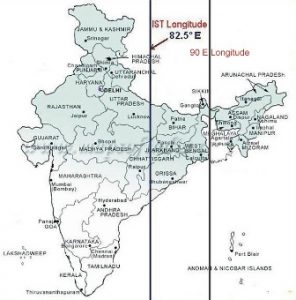
Many Indian outsourcing firms offer to work almost the same office hours as their clients – they will work “in your time zone” so to speak. They also analysed the importance of synchronising office hours - as well as biological activities - to sunrise and sunset timings.Indian office hours in your time zone: 11:30 PM to 08:30 AM EDT

The researchers estimated energy savings at 20 million kWh a year based on a formula explained in the article. The paper explains the choice of the line: “As the railway signals have not yet been fully automated in the country, the border between the two time zones should have a very narrow spatial-width with minimum number of train stations so that the train timings while crossing the border can be managed manually without any untoward incidents.” States east of the line - Assam, Meghalaya, Nagaland, Arunanchal Pradesh, Manipur, Mizoram, Tripura, Andaman & Nicobar Islands -would follow IST-II. States west of the line would continue to follow IST (to be called IST-I). The proposed line of demarcation is at 89★2’E, the narrow border between Assam and West Bengal. The research paper proposes to call the two time zones IST-I (UTC + 5.30 h) and IST-II (UTC + 6.30 h). It had cited the same committee’s findings in the Gauhati High Court, which last year dismissed a public interest litigation seeking a direction to the Centre to have a separate time zone for the Northeast. A committee set up in 2002 did not recommend two time zones because of the complexities involved, the government said. In March, in reply to a question in Parliament, the government said it has not taken any decision on separate time zones. This has led to the argument that early sunrise in the easternmost parts - the Northeast - causes the loss of many daylight hours by the time offices or educational institutions open, and that early sunset, for its part, leads to higher consumption of electricity. India extends from 68☇’E to 97☂5’E, with the spread of 29° representing almost two hours from the geographic perspective.

While India follows one IST, the United States follows several time zones across its breadth. At 82☃3’E, the line is 82.5° east of Greenwich, or 5.5 hours (5 hours 30 minutes) ahead of UCT. Indian Standard Time, maintained by CSIR-NPL, is based on a line of longitude that runs through Mirzapur in UP. It identifies GMT, now known as Universal Coordinated Time (UTC), which is maintained by the Bureau of Weights and Measures (BIPM) in France. The geographic “zero line” runs through Greenwich, London. This is “legal time”, as defined by a country’s law.

Political boundaries, however, mean that time zones are often demarcated by bent lines rather than straight lines of longitude. Theoretically, the time zone followed by any place should relate to its longitudinal distance from any other place. Because the Earth spins 360° in 24 hours, a longitudinal distance of 15° represents a time separation of 1 hour, and 1° represents 4 minutes. If lines of longitude are drawn exactly a degree apart, they will divide the Earth into 360 zones. READ | Govt says no decision made yet on separate time zones in IndiaĪ look at the debate, and the new suggestions:


 0 kommentar(er)
0 kommentar(er)
